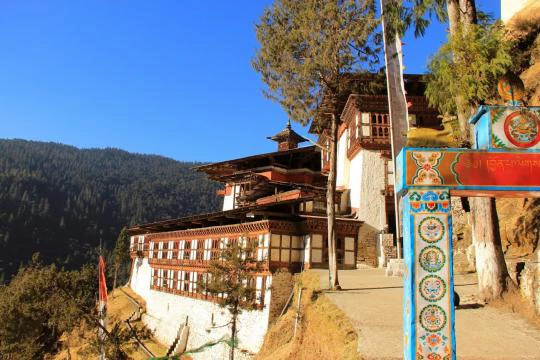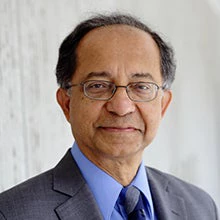Landing at Paro in Bhutan involves making a question-mark shaped maneuver while dropping altitude rapidly to avoid making wing-contact with the Himalayan mountains surrounding the Paro valley where Thimphu, the capital, is also situated. A fellow passenger informs me that there are only 9 pilots in the world who are trained to make this landing. I use up one of my rare prayers to request that it be one of those flying us now. It is, I think, the infrequency of prayers that makes them so effective; our plane descends smoothly and tiptoes on to the tarmac.
During my four-day visit, I start by meeting with and lecturing to economics students from Bhutan and the neighboring countries--India, Bangladesh, Sri Lanka, Pakistan, Nepal, and Afghanistan—brought together as part of a program to build intra-regional intellectual cooperation and understanding, sponsored by the World Bank; I conclude my Bhutan visit by dining with and engaging in a roundtable-conversation with policymakers, thought-leaders and corporate heads from around the country. Between those opening and closing events, I have two meetings with the engaging Prime Minister, Tshering Tobgay, on challenges facing Bhutan and the region; I meet and consult with the Finance Minister as well as with officials of the Central Monetary Authority; converse with the Director of the Center for Bhutan Studies, Dasho Karma Ura, and engage in a memorable conversation with His Majesty, the fifth King of Bhutan, Jigme Khesar Namgyel Wangchuck.
A highlight of the trip was a visit to two urban infrastructure development projects in the Thimphu suburbs, with the Mayor of the capital, Kinlay Dorjee, and Genevieve Boyreau, the Bank’s Resident Representative and Senior Economist. The projects are being supported by the World Bank Group. Amidst all of this I also manage to walk up, with the World Bank’s Joe Qian, to the magical Cheri Monastery and come down after two hours, feeling as though I had spent a week at a meditation camp.

Bhutan is an amazing country, embodying simultaneously tradition and modernity, rarely seen elsewhere. There is a deep-seated heritage of Buddhism and innate simplicity that marks all aspects of life. This is combined with a striving for high environmental standards, organic farming and an attempt at a smoking ban not just in buildings and parks, but in the nation.
Much of Bhutan’s challenge for development stems from these twin traits of deeply held tradition and a drive towards a modern notion of sustainability. This is a nation that has had remarkable success in fighting extreme poverty. The percentage of people living below the poverty line of $1.25 (PPP-adjusted) fell from 47% in 1981 to 3% in 2011. In percentage terms this is the sharpest fall, a shade faster than China’s decline from 84% to 6% over the same period. As reported in the Bank’s Bhutan Poverty Assessment 2014, growth in the country has been inclusive and Bhutan is a society graced with a high degree of social mobility.
Nevertheless, there are some clouds of concern. After a period of rapid development, including double-digit growth in 2011, the GDP growth rate slowed down 2.1% in 2013 as a result of the global slowdown and domestic macro-structural strains, including a high current account deficit. Moreover, unemployment, while not high by Eurozone standards, has risen, and, in particular, there is a perceptible rise in unemployment among educated youth.
To attend to these challenges while preserving the nation’s admirable cultural heritage and environmental commitments is not easy; this came up in virtually every discussion forum and bilateral meeting, as did the topic of regional cooperation among the eight SAARC countries, which is particularly important to Bhutan, since it is a small land-locked nation.
The nation’s big business is hydro-electric power generation and export of power to India. Another sector with significant potential is tourism. The country has an interesting tourism policy, which consists of requiring, with minimal exceptions, that each tourist spend at least $250 per day. While the urge to follow a “high value, low impact” tourism policy is understandable, it is not obvious that the method currently used is optimal. For one, I believe Bhutan can afford to charge more in the peak season and less in the lean season to improve on utilization rates and increase the revenue earned from tourism. Moreover, it can use nonlinear pricing, and possibly even alternative auction systems and increase the revenue it earns from this sector.
I have no precise solutions to offer but I know that by using good analysis and a little operations research, the nation can enhance its earnings from and employment-generation capacity of the tourism sector. I know this from experience because when I worked in India and the government was planning to auction 3G spectrum, our estimate was that this had a value of approximately 5 billion dollars. Luckily, the government decided to use a professionally-designed auction instead of selling it at the government-estimated price; the money raised turned out to be three times the estimate. It is difficult to over-emphasize the power of good policy design.
With its success in nurturing human capital and health, Bhutan should also be able to develop its education and information technology and digital data management sectors. These advances could help absorb its educated labor force.
Finally, there is indeed scope for huge developments in inter-regional trade, travel and tourism. South Asia is one of the least economically integrated regions of the world. Success in advancing inter-regional economic cooperation is of course not within the reach of any single country. Much will depend on collective determination and also the resolve of the big country of the region, India. This should however be treated as a priority for South Asia and maybe little Bhutan can play a neutral role in egging on the big players.
Successful and prominent cities and regions in Asia and, more generally, the Orient are often named as “such-and-such place of the East.” After four magical days in Bhutan, nestled peacefully in the high mountains, with a warm and friendly citizenry, I have decided that, reversing this tradition, I shall now think of Switzerland as the Bhutan of the West.


Join the Conversation